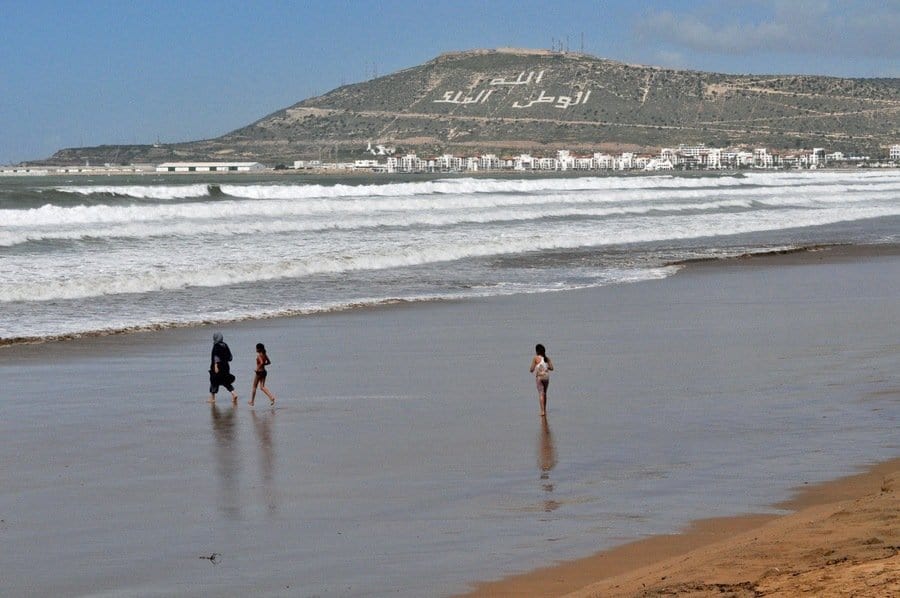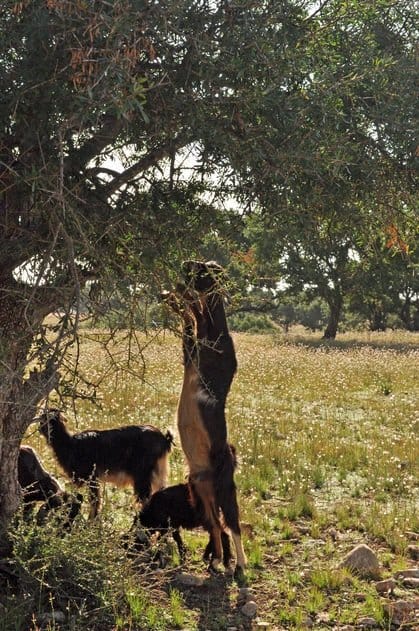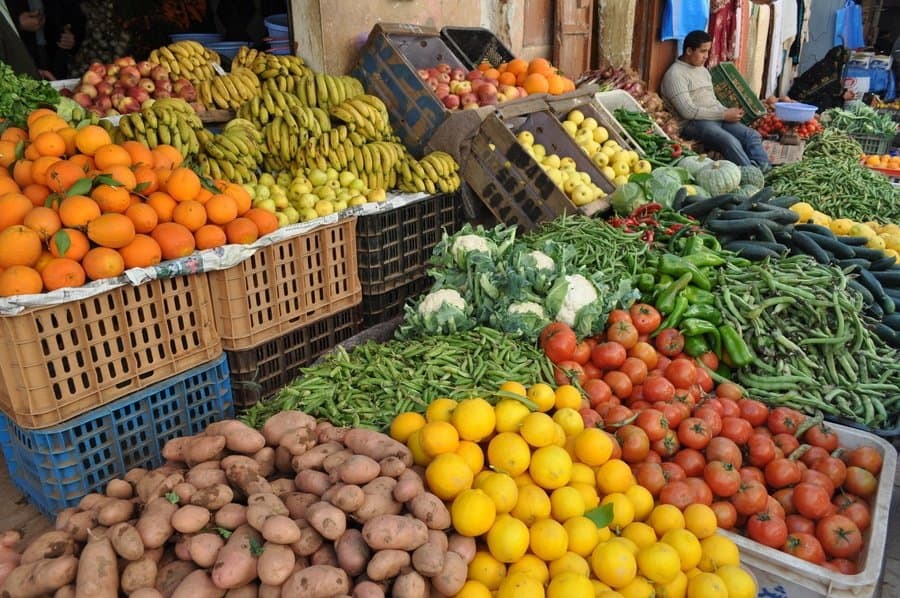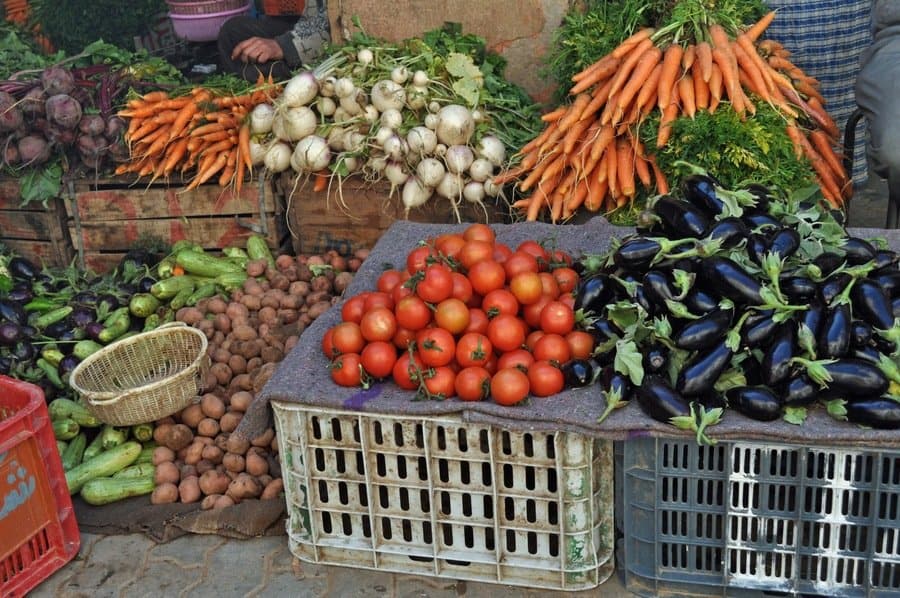Agadir in southwest Morocco with its sun, sea and surf is perfect for a winter sunshine break but if you’re looking for traditional Moroccan style you won’t find it. The town has a distinct European feel as it was completely rebuilt after a devastating earthquake destroyed it in 1960 tragically killing 15,000 inhabitants.

“God, Country and King”
Agadir Beach

Agadir’s long, wide sandy beach lined with restaurants, bars and hotels is the main attraction, as are the beaches further north, their rolling white breakers drawing the surf crowd. Although we were happy soaking up some sun, whilst the snow settled back home, it wasn’t long before I got twitchy and felt the need to search out some traditional local colour.
There are some interesting historical towns within striking distance of Agadir and we booked a tour with a local guide to Taroudant. This authentic Berber market town sits in the heart of the Souss Valley with a backdrop of the Anti Atlas mountains and has the best preserved town walls in Morocco. To give you an idea it also goes by the moniker of Little Marrakech.
Flying Goats
We’re picked up at our hotel by a driver and our guide, Sala, wearing a blue cotton shesh – a Berber style turban – and start out for Taroudant which is about an hours drive inland from Agadir. As we drive through the fertile Souss Valley see the distant snow-capped peaks of the Atlas mountains, catch sight of a caravan of around 30 dromedaries owned by nomad Berbers and pass lush green orange groves the fruit ripe and ready.
We also spy the infamous Moroccan ‘Flying Goats’ – well not exactly flying – more just climbing trees. The nimble goats clamber around the branches of the Argan trees munching on the foliage. We stop the car to take a closer look and the herders are more than happy for us to take photos – for a few coins of course - but worth every dirham because I’m still smiling about those goats. The goats seemed quite bemused by us too.
Taroudant
We arrive at Taroudant, the apricot castellated ramparts concealing the bustle within, and enter the town through one of the nine ancient gateways.

We have two hours in Taroudant; time to navigate the two small souks, stop off in the main square and soak up some real Moroccan life. Men wearing hooded Djellabas and soft leather slippers slip quickly by while women draped head to foot in indigo blue, the Berber national colour, provide a bright contrast against the sun-bleached buildings.
The Souk Arab is a maze of alleyways selling local handicrafts; silverware, carved limestone, ceramics, saffron, spices, lanterns and leather. I buy a mini tagine trio that I’m not really sure what to do with now I’ve got it home – the haggling with the shopkeeper was lighthearted although he was far more skilled at it than me! Having said that people aren’t pushy and don’t approach us unless we show an interest – some are positively shy and it’s not hugely touristy.
The Marche Berbere, the other souk in town, is the food market packed with local people. It’s lively and colourful; fruit and vegetables fresh and vibrant are beautifully displayed in alluring patterns – Morocco knows how to do patterns. The mouth-watering smell of street food and spices waft from stalls and doorways and the summer-sweet smell of strawberries hit the senses as we pass by wooden carts stacked with pyramids of the ripe red fruit. Cuts of meat hang from butchers windows that open straight onto the street and a large, plucked turkey languishes awaiting its fate. Flat breads are stacked high. All the while the rasping whine of a Ghita, the Moroccan flute, follows us through the narrow alleyways. This small enclave and former Berber stronghold buzzes with life.
Near the Square we came across some women demonstrating how they produce Argan oil. I found this interesting as this was a very different scenario from the Fairtrade Womens Cooperative I visited in Tighanimine the day before – I’ll be writing about those amazing women in a future post.
We finished our visit with a stop in the heart of the town in the main square, Place Assarag, and find a café with a roof terrace. This is a good move because it means we get a great view of the square’s goings-on and can drink in the atmosphere with our mint tea without any hassle from the shouty man with the cobra in a basket. It’s huge entertainment watching him get everyone else though!

If you’re in Agadir and want to see a slice of real Moroccan life then Taroudant is the perfect day out. At only an hours drive away it’s much nearer than the three hours to Marrakech – the people in the souks are a lot less pushy and the atmosphere friendlier. You may even see some flying goats on the way!
We were picked up at 8:30 am returning at 14:00. We had plenty of room in a large 4×4 which we shared with one other couple at a cost of €18 pp. We booked through the hotel with a local tour company.
morocco culture,moroccan food,morocco food,moroccan cuisine,morocco beaches,moroccan meal,beaches in morocco,moroccan culture,hercules cave,hercules cave morocco


















